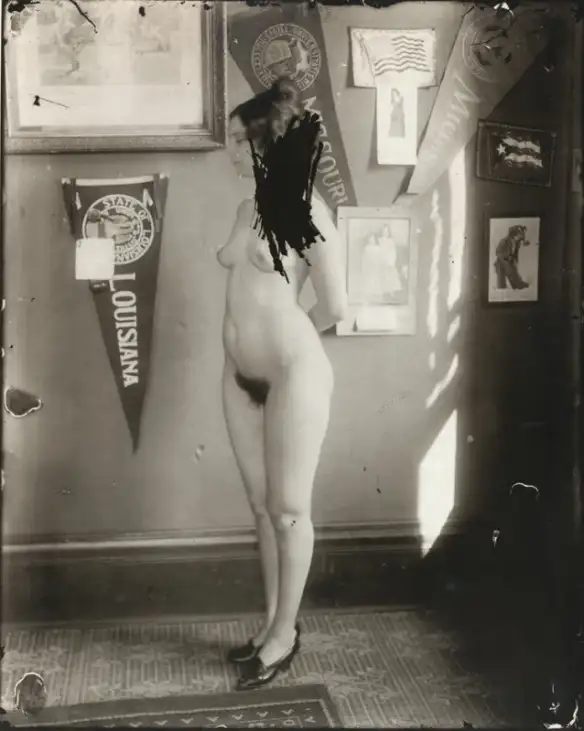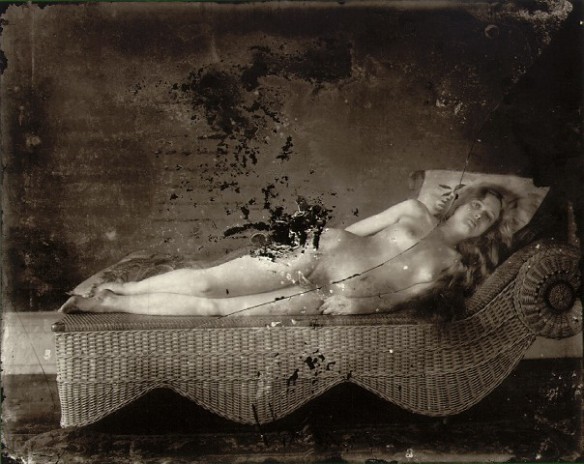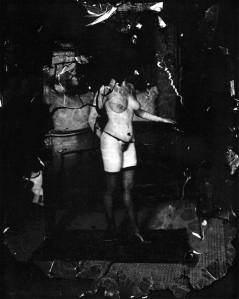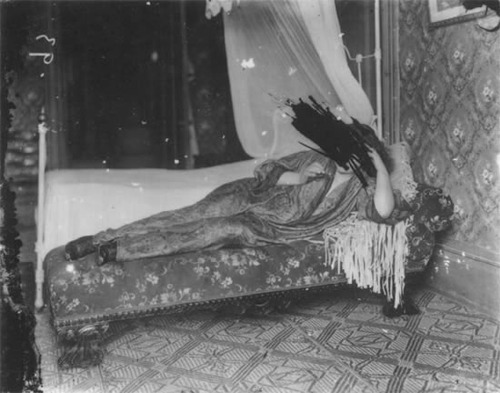An Ode to an Anatomical Venus: Waxing Poetic on the Uncanny Allure of 18th Century Dissectible Women
by Joanna Ebenstein / 14 Feb 2013
"Anatomical Venus," wax wodel with human hair and pearls in rosewood and Venetian glass case, "La Specola" (Museo di Storia Naturale), Florence, Italy; Probably modeled by Clemente Susini (around 1790)
An essay
from collector, photographer, artist, and friend of the Atlas Obscura,
Joanna Ebenstein of Morbid Anatomy about her love of the Wax Anatomical
Venus.
Much of my artwork, scholarship, and work with the Morbid Anatomy Blog and Library
revolves around the luxuriously bizarre Anatomical Venus, a kind of
female wax anatomical model popularized in the 18th century. Over the
past six years, I have made it my goal to find — and photograph! — as
many of these amazing pieces as possible, and to learn as much as I can
about these lovely ladies, with a special eye towards understanding the
historical moment in which they rose to prominence as the ideal way to
illuminate the anatomy of woman for a popular audience. I was recently
invited to contribute an article on this topic to the "Enchantment"
special issue of WSQ: Women's Studies Quarterly. Below is an excerpt from this piece, "Ode to an Anatomical Venus," and some of my photographs of these wax women.
The "Venerina" or "Little Venus" anatomical model by Clemente Susini, 1782, as seen at the Palazzo Poggi in Bologna, Italy.
Described on the museum website thusly: "The agony of a young woman is
represented in her last instant of life as she abandons herself to death
voluptuously and completely naked. The thorax and abdomen can be
opened, allowing the various parts to be disassembled so as to simulate
the act of anatomic dissection."
Clemente Susini’s Anatomical Venus, created around 1790, is the
central object of my artistic and scholarly contemplation. She is, in my
opinion, the perfect object; one whose luxuriously bizarre existence
challenges belief. It — or, better she — was conceived of as a
means to teach human anatomy without the need for constant dissection,
which was messy, ethically fraught, and subject to quick decay. The
Venus also tacitly communicated the relationship between the human body
and a divinely created cosmos, between art and science, between nature
and mankind as understood in its day.
Detail of the ”Venerina" (Little Venus) anatomical model by Clemente Susini, 1782, Palazzo Poggi, Bologna, Italy
Referred to also as "The Demountable Venus," this life-sized,
dissectible wax woman — who can still be viewed in her original Venetian
glass and rosewood case at La Specola Museum of Zoology and Natural History in Florence, Italy,
as well as in a number of other European museums — is adorned with
glass eyes and human hair and can be dismembered into dozens of parts
revealing, at the final remove, a beatific fetus curled in her womb. Her
sisters — also anatomical models made under the artistic leadership of
Susini, and referred to by such names as "The Slashed Beauty" and "The
Dissected Graces" can be visited at a handful of European museums.
Supine in their glass boxes, they beckon with a gentle smile or an
ecstatic downcast gaze; one idly toys with a plait of real golden human
hair; another clutches at the plush, moth-eaten velvet cushions of her
case as her torso erupts in a spontaneous, bloodless auto-dissection;
another is crowned with a golden tiara, while yet another has a silk
ribbon tied in a bow tied around a dangling entrail. 
Anatomical model by Clemente Susini representing "deep lymphatic vessels in a female subject," human hair, wax, 1794, Museum of the History of the University, Pavia, Italy
Since their creation in late-18th century Florence, these wax women have seduced, intrigued, and instructed. Today, they also confound, troubling the edges of our neat categorical divides: life and death, science and art, body and soul, effigy and pedagogy, spectacle and education, kitsch and art. They are corporeal martyrs, anatomical odalisques, the uncanny incarnate. These wax models are the pinnacle of "artificial anatomies," a tradition of three-dimensional, anatomical teaching tools stretching back to the turn of the 18th century. The genre came into being around 1700 when Gaetano Giulio Zummo, known as Zumbo, accepted the commission of French surgeon Guillaume Desnoues to create a likeness of an important medical dissection that was beginning to decompose. Zumbo was a Sicilian abbot who delighted in the creation of wax miniature series “Theatres of Death” boasting names such as "The Plague" and "The Vanity of Human Greatness," and featuring exactingly rendered dead and tortured bodies. The product of Desnoues' and Zumbo's collaboration was the first wax anatomical teaching model, and established the tradition of an artistic/medical partnership in the creation of such tools.

"Slashed Beauty" Wax wodel with human hair and pearls in rosewood and Venetian glass case, "La Specola" (Museo di Storia Naturale), Florence, Italy; Probably modeled by Clemente Susini (around 1790)
The Venus and her sisters were intended, from their very conception, not only to instruct, but also to delight and elicit the wonder of a popular audience and, beginning with their public debut in the 1790s, they did just that, attracting throngs of both local Tuscans and visitors on the Grand Tour circuit. Their popularity was so great that they ultimately inspired a series of knockoffs — first a series of similar models by the same workshop for Napoleon and Joseph II of Vienna and, later, in series of models, often advertised as "Florentine" or "Parisian" or even automated breathing Venuses that toured Europe, attracting masses of visitors to the popular anatomical displays found in Europe well into the 20th century. The uncanny allure of these somnambulant, neither-dead-nor-alive women was not lost on surrealist artists such as Paul Delvaux — who cited his visits to the Spitzner Collection (as seen in his painting "Le Musee Spitzner" of 1943), with its famous breathing Venus as a life and art-changing moment — and Marcel Duchamp, whose enigmatic peepshow Étant donnés seems to have been inspired, at least in part, by the paradoxes embodied by such figures.

"The Slashed Beauty"Wax model with human hair in rosewood and Venetian Glass case; Probably modeled by Clemente Susini (around 1790), "La Specola" (Museo di Storia Naturale), Florence, Italy
At the time these models were conceived of and created, the anatomy of woman was of great interest, in both the medical and social arenas; the residue of these concerns, as argued by scholar Ludmilla Jordanova in Sexual Visions, can be found in the Anatomical Venus and other anatomical waxes of the era. The anatomy of woman was understood at this time to be the exception to the canonical body of the male: problematic, erratic, and troubling. It was also understood to be intimately tied to the female temperament, which was thought to be sensible (ie, sensitive), nervous, passionate, childlike, passive, and prone to such nervous disorders as hysteria — literally, "wandering womb." Men, in contrast, were understood to be muscular, vigorous, and reasonable. This difference is reflected in the models from the workshop of Susini. Each of his Venuses features a fetus — the raison d’être of woman, after all! — at the last stage of anatomical striptease. And, while male figures can be represented standing or reclining — and more often than not were portrayed completely skinned, demonstrating, say, human musculature — all the female figures are reclining and with their hyper-perfect skin intact, except for the places where the anatomical elements are exposed. The female figure, then, always remains beautiful and, one could argue, sexually desirable, and it is the line between her classic, serene beauty and the abjectness of her innards that adds to her special frisson.

"Anatomical Venus" Wax wodel with human hair and pearls in rosewood and Venetian glass case, "La Specola" (Museo di Storia Naturale), Florence, Italy; Probably modeled by Clemente Susini (around 1790)
This frisson seemed to be a formula for popular success, so it is no surprise that Susini’s Venus and her sisters were not the first to employ it. Indeed, in 1719, Desnoues, the French surgeon who partnered with Zumbo in the creation of the first anatomical model, exhibited to the public a wax dissectible anatomized woman featuring a newborn child with the umbilical cord still attached. Fourteen years later, the Paris-trained anatomist, surgeon, and modeler Abraham Chovet exhibited in London ‘‘. . . the representation of a woman big with child chained upon a table; supposed to be opened alive. In the face there is a lively display of the agonies of a dying person, the whole body heaving and the hands clinched, the action suitable to the character of the subject.’’ This ingenious piece demonstrated the circulation of the blood during pregnancy via an network of blown glass tubes coursing with blood-red claret.
You can read the entire "Ode to an Anatomical Venus" piece by clicking here.
This piece could simply not exist without the wonderful work of scholars Roberta Ballestriero, Alessandro Riva, Lucia Dacome, Kathryn Hoffmann, Ludmilla Jordanova, Martin Kemp and Marina Wallace, Anna Maerker, Rebecca Messbarger, and Roberta Panzanelli. A much more detailed bibliography and list of citations can be found in the article itself. I am entirely indebted to their work in all of my research on this topic.
"Anatomical Venuses" Wax models with human hair
in rosewood and Venetian glass cases; Workshop of Clemente Susini of
Florence, 1781-1786 The Josephinum, Vienna, Austria
















































